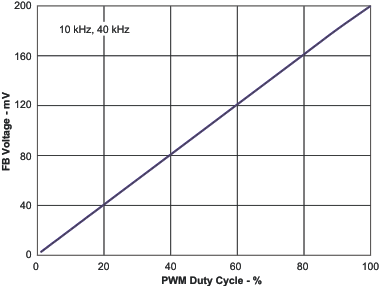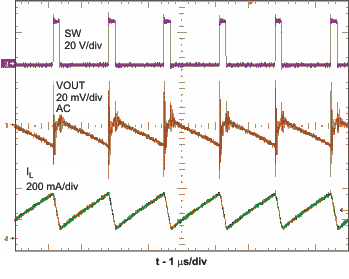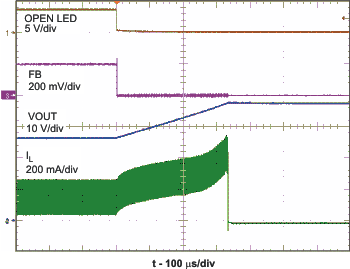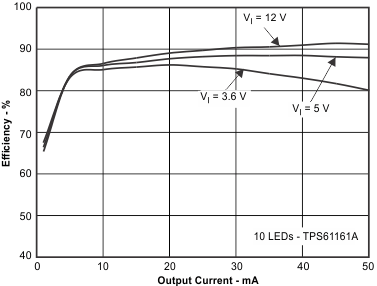SLVS937C March 2009 – July 2016 TPS61160A , TPS61161A
PRODUCTION DATA.
- 1 Features
- 2 Applications
- 3 Description
- 4 Revision History
- 5 Pin Configuration and Functions
- 6 Specifications
- 7 Detailed Description
- 8 Application and Implementation
- 9 Power Supply Recommendations
- 10Layout
- 11Device and Documentation Support
- 12Mechanical, Packaging, and Orderable Information
6 Specifications
6.1 Absolute Maximum Ratings
over operating free-air temperature range (unless otherwise noted)(1)| MIN | MAX | UNIT | ||
|---|---|---|---|---|
| VI | Supply voltages on VIN(2) | –0.3 | 20 | V |
| Voltages on CTRL(2) | –0.3 | 20 | V | |
| Voltage on FB and COMP(2) | –0.3 | 3 | V | |
| Voltage on SW(2) | –0.3 | 40 | V | |
| PD | Continuous power dissipation | See Dissipation Ratings | ||
| TJ | Operating junction temperature | –40 | 150 | °C |
| Tstg | Storage temperature | –65 | 150 | °C |
(1) Stresses beyond those listed under Absolute Maximum Ratings may cause permanent damage to the device. These are stress ratings only, and functional operation of the device at these or any other conditions beyond those indicated under Recommended Operating Conditions is not implied. Exposure to absolute-maximum-rated conditions for extended periods may affect device reliability.
6.2 ESD Ratings
| MIN | MAX | UNIT | |||
|---|---|---|---|---|---|
| V(ESD) | Electrostatic discharge | Human body model (HBM), per ANSI/ESDA/JEDEC JS-001, all pins(1) | 4000 | V | |
| Charged device model (CDM), per JEDEC specification JESD22-C101, all pins(2) | 1000 | ||||
(1) JEDEC document JEP155 states that 500-V HBM allows safe manufacturing with a standard ESD control process.
(2) JEDEC document JEP157 states that 250-V CDM allows safe manufacturing with a standard ESD control process.
6.3 Recommended Operating Conditions
| MIN | NOM | MAX | UNIT | ||
|---|---|---|---|---|---|
| VI | Input voltage, VIN | 2.7 | 18 | V | |
| VO | Output voltage | VIN | 38 | V | |
| L | Inductor(1) | 10 | 22 | μH | |
| fdim | PWM dimming frequency(2) | 5 | 100 | kHz | |
| tPWM_MIN | Minimum pulse width at PWM input | 50 | ns | ||
| CIN | Input capacitor | 1 | μF | ||
| CO | Output capacitor(1) | 0.47 | 10 | μF | |
| TA | Operating ambient temperature | –40 | 85 | °C | |
| TJ | Operating junction temperature | –40 | 125 | °C |
(1) These values are recommended values that have been successfully tested in several applications. Other values may be acceptable in other applications but should be fully tested by the user.
(2) The device can support the frequency range from 1 kHz to 5 kHz, based on the specification, toff . The output ripple needs to be considered in the range of 1 kHz to 5 kHz.
6.4 Thermal Information
| THERMAL METRIC(1) | TPS61160A, TPS61161A | UNIT | |
|---|---|---|---|
| DRV (WSON) | |||
| 6 PINS | |||
| RθJA | Junction-to-ambient thermal resistance | 140 | °C/W |
| RθJC(top) | Junction-to-case (top) thermal resistance | 20 | |
(1) For more information about traditional and new thermal metrics, see the IC Package Thermal Metrics application report, SPRA953.
6.5 Dissipation Ratings
| BOARD PACKAGE | RθJC | RθJA | DERATING FACTOR ABOVE TA = 25°C | TA < 25°C | TA = 70°C | TA = 85°C |
|---|---|---|---|---|---|---|
| Low-K(1)DRV | 20°C/W | 140°C/W | 7.1 mW/°C | 715 mW | 395 mW | 285 mW |
| High-K (2)DRV | 20°C/W | 65°C/W | 15.4 mW/°C | 1540 mW | 845 mW | 615 mW |
(1) The JEDEC low-K (1s) board used to derive this data was a 3 in × 3 in, two-layer board with 2-ounce copper traces on top of the board.
(2) The JEDEC high-K (2s2p) board used to derive this data was a 3 in × 3 in, multilayer board with 1-ounce internal power and ground planes and 2-ounce copper traces on top and bottom of the board.
6.6 Electrical Characteristics
VIN = 3.6 V, CTRL = VIN; for Min/Max values TA = –40°C to 85°C, typical values are at TA = 25°C (unless otherwise noted)| PARAMETER | TEST CONDITIONS | MIN | TYP | MAX | UNIT | |
|---|---|---|---|---|---|---|
| SUPPLY CURRENT | ||||||
| VI | Input voltage range, VIN | 2.7 | 18 | V | ||
| IQ | Operating quiescent current into VIN | Device PWM switching no load | 1.8 | mA | ||
| ISD | Shutdown current | CRTL = GND, VIN = 4.2 V | 1 | μA | ||
| UVLO | Undervoltage lockout threshold | VIN falling | 2.2 | 2.5 | V | |
| Vhys | Undervoltage lockout hysteresis | 70 | mV | |||
| ENABLE AND REFERENCE CONTROL | ||||||
| V(CTRLh) | CTRL logic high voltage | VIN = 2.7 V to 18 V | 1.2 | V | ||
| V(CTRLl) | CTRL logic low voltage | VIN = 2.7 V to 18 V | 0.4 | V | ||
| R(CTRL) | CTRL pull down resistor | 400 | 800 | 1600 | kΩ | |
| toff | CTRL pulse width to shutdown | CTRL high to low | 2.5 | ms | ||
| VOLTAGE AND CURRENT CONTROL | ||||||
| VREF | Voltage feedback regulation voltage | 196 | 200 | 204 | mV | |
| V(REF_PWM) | Voltage feedback regulation voltage under brightness control | VFB = 50 mV | 47 | 50 | 53 | mV |
| VFB = 20 mV | 17 | 20 | 23 | |||
| IFB | Voltage feedback input bias current | VFB = 200 mV | 2 | μA | ||
| fS | Oscillator frequency | 500 | 600 | 700 | kHz | |
| Dmax | Maximum duty cycle | VFB = 100 mV | 90% | 93% | ||
| tmin_on | Minimum on pulse width | 40 | ns | |||
| Isink | Comp pin sink current | 100 | μA | |||
| Isource | Comp pin source current | 100 | μA | |||
| Gea | Error amplifier transconductance | 240 | 320 | 400 | μmho | |
| Rea | Error amplifier output resistance | 6 | MΩ | |||
| fea | Error amplifier crossover frequency | 5 pF connected to COMP | 500 | kHz | ||
| POWER SWITCH | ||||||
| RDS(on) | N-channel MOSFET on-resistance | VIN = 3.6 V | 0.3 | 0.6 | Ω | |
| VIN = 3 V | 0.7 | |||||
| ILN_NFET | N-channel leakage current | VSW = 35 V, TA = 25°C | 1 | μA | ||
| OC and OLP | ||||||
| ILIM | N-Channel MOSFET current limit | D = Dmax | 0.56 | 0.7 | 0.84 | A |
| ILIM_Start | Start up current limit | D = Dmax | 0.4 | A | ||
| tHalf_LIM | Time step for half current limit | 5 | ms | |||
| Vovp | Open LED protection threshold | Measured on the SW pin, TPS61160A TPS61161A |
25 37 |
26 38 |
27 39 |
V |
| V(FB_OVP) | Open LED protection threshold on FB | Measured on the FB pin, percentage of Vref, Vref = 200 mV and 20 mV |
50% | |||
| tREF | VREF filter time constant | 180 | μs | |||
| tstep | VREF ramp up time | 213 | μs | |||
| THERMAL SHUTDOWN | ||||||
| Tshutdown | Thermal shutdown threshold | 160 | °C | |||
| Thysteresis | Thermal shutdown threshold hysteresis | 15 | °C | |||
6.7 Typical Characteristics
Table 1. Table of Graphs
| FIGURE | ||
|---|---|---|
| Efficiency TPS61160A/61A | VIN = 3.6 V; 4, 6, 8, 10 LEDs; L = 22 μH | Figure 1 |
| Efficiency TPS61160A | Figure 2 | |
| Efficiency TPS61161A | Figure 3 | |
| Current limit | TA = 25°C | Figure 4 |
| Current limit | Figure 5 | |
| PWM dimming linearity | VIN = 3.6 V; PWM Freq = 10 kHz and 40 kHz | Figure 6 |
| Output ripple at PWM dimming | 8 LEDs; VIN = 3.6 V; ILOAD = 20 mA; PWM Freq = 10 kHz | Figure 7 |
| Switching waveform | 8 LEDs; VIN = 3.6 V; ILOAD = 20 mA; L = 22 μH | Figure 8 |
| Start-up | 8 LEDs; VIN = 3.6 V; ILOAD = 20 mA; L =22 μH | Figure 9 |
| Open LED protection | 8 LEDs; VIN = 3.6 V; ILOAD = 20 mA; L = 22 μH | Figure 10 |
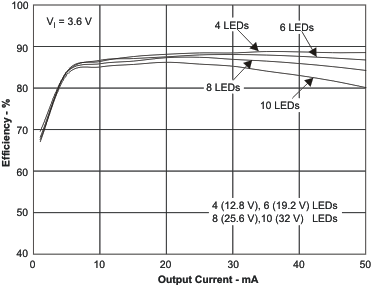 Figure 1. Efficiency vs Output Current
Figure 1. Efficiency vs Output Current
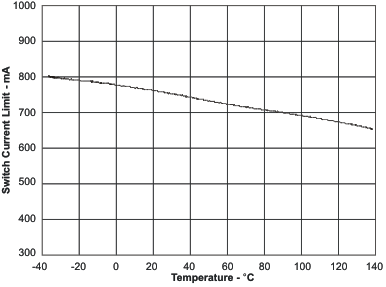
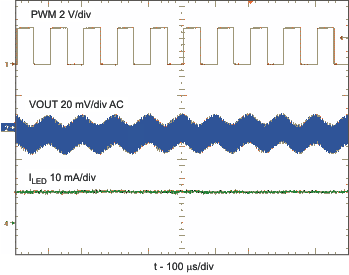
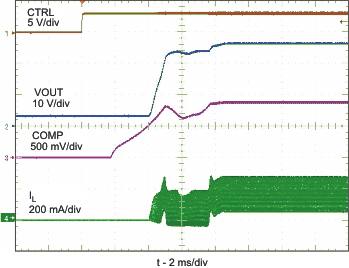
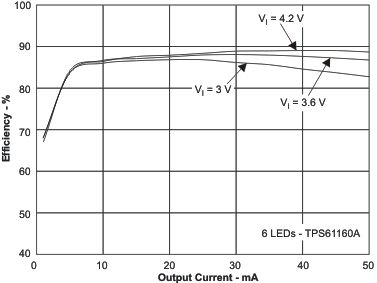 Figure 2. Efficiency vs Output Current
Figure 2. Efficiency vs Output Current
 Figure 4. Switch Current Limit vs Duty Cycle
Figure 4. Switch Current Limit vs Duty Cycle
